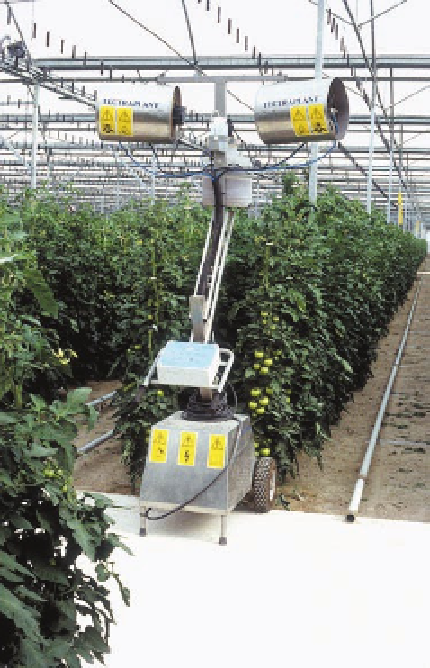Agriculture Reference
In-Depth Information
organization of work; and (iii) the automa-
tion of operations, such as fertigation.
A well-conceived circuit of passages
and roads which allows for easy removal of
the products from the greenhouse is of pri-
mary importance, because harvesting is one
of the most labour-intensive operations in
greenhouse vegetable production. Any point
inside the greenhouse must be close to an
accessible passage for a vehicle or trolley;
this distance must not exceed 20 or 30 m.
The situation of the different buildings
annexed to the greenhouse must ease and
minimize the traffic.
The greenhouses must have double
access (interlocking) doors, to limit entrance
of insects, wide enough to allow for the
machinery to pass through and with simple
opening-closing systems, allowing for good
insulation and airtightness.
sophisticated equipment is available on
the market (Photo 12.2).
In crops trained to grow tall, the diver-
sity of work operations (pruning, defolia-
tion, harvest) that must be performed at a
certain height, induced the development of
different systems to lift the workers from
the ground level, such as lifting platforms.
In other cases, in crops like tomato, differ-
ent plant lowering and training techniques
allow for working at the soil level.
Handling the harvested product is a
highly labour intensive operation, if it is not
well thought out and organized. The effi-
ciency in the use of several types of trolleys
and transport elements will depend on the
specific characteristics of each greenhouse.
The use of guiding rails, which act simulta-
neously as heating pipes, is widespread
(Photo 12.3). Some sophisticated greenhouses
used as nurseries or for ornamental crops also
have aerial transportation systems.
12.3.2
Mechanization of operations
The operations to prepare the soil can be
mechanized, because there are several roto-
vators (one-wheeled tractor) and small
articulated tractors, with a wide range of
implements for these operations. Sowing or
transplanting is usually performed by hand,
although it can be mechanized for large
areas.
Irrigation and fertilization, given the
general use of HFLI (normally drip irriga-
tion), are automated, to a varying degree
depending on the specific characteristics of
the fertigation head used.
Pesticide treatments are usually per-
formed by means of spraying. In small
greenhouses, they can be done with light
equipment such as backpacks or with
movable sprayers equipped with a small
tank, pump and hoses, powered by a trac-
tor, a dedicated petrol engine or a small
electric motor. In larger greenhouses, a
fixed-pipe network is usually installed
inside the greenhouse to which the hoses
are connected, the tank and the pumping
system remaining in the service areas out-
side the greenhouse (Aranda, 1994). For
ultra-low volume treatments appropriate
Photo 12.2.
Mobile equipment for greenhouse
pesticide treatments.

